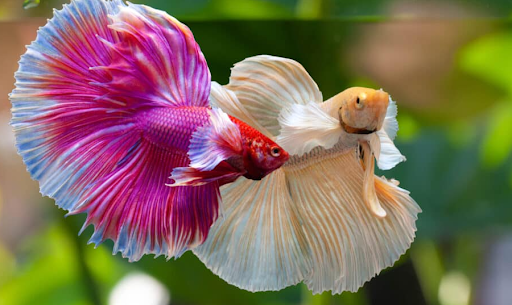Female Bettas are very interesting fish. Their interesting breeding habits make them a lot more than just a pretty face. There’s so much to know about how bettas breed and how to keep them happy and healthy as well. Bettas are known for their beautiful colors, but sometimes their colors go beyond what people usually see. Often, you can find blue or red-and-white betta fish. Blue is usually the result of crossbreeding with other species like triggerfish or paradise fish, whereas the red and white coloration is an indication that your pregnant betta fish is pregnant. Keep reading to find out everything you ever wanted to know about breeding bettas and how long they are pregnant…
How Long Is A Betta Fish Pregnant?
Breeding females can be identified by their fat, swollen bellies. They might look a little like they’re about to give birth to a human baby, but no worries — they’re pregnant with eggs. To breed bettas, you will need a male and female betta, a tank large enough to accommodate the pregnant female, a breeding trap, and plenty of fresh, clean water. When breeding bettas, you will have to keep the female separated from the male at all times until she’s ready to spawn.
The pregnant female will have already been conditioned to spawn, so she is likely to start digging a pit in the tank once she’s ready. She’ll make a bubble nest out of her mouthful of saliva. This bubble nest is where the eggs will fall as she releases them one at a time into the nest. You’ll want to make sure the nest is in an area where the male can easily find it.
The Process Of Breeding Bettas
The first step to breeding bettas is to make sure the fish are healthy, with no diseases or parasites. You also need to be sure they are compatible with each other, and they will not harm each other while breeding. To check compatibility, you can put the two fish in a tank together and see how they interact. If they attack each other, they are not compatible. If they are compatible, you can put them in a breeding tank.
A breeding tank should be at least 10 gallons per fish and have a heater, filter, and plenty of hiding spots. You will also need a bucket or plastic container that has air holes drilled into the top. The breeding tank should be completely dark because bettas are naturally nocturnal and will spawn in complete darkness.
Understanding The Signs Of A Pregnant Betta
A pregnant betta will start to grow a lot fatter than usual, and her stomach may even look a bit swollen. She will also be very aggressive, even towards her kind. This can happen even to fish she was friendly with before she became pregnant. If you see one of your bettas swollen or aggressive, there is a good chance she is pregnant.
Now you need to decide how you want to proceed. If you want to breed your bettas, you need to separate the pregnant female from the rest of the fish. She can’t be around the other fish, or she will kill them. Once she has spawned and released her fry, she will be ready to be put back in with the other fish again.
When Is A Betta Born?
Bettas usually spawn when the water temperature is around 24 degrees Celsius. The cycle from mating to spawning can take between one and four weeks. Once the pregnant female has spawned, she will eat her bubble nest and the eggs. If you want to collect the eggs and raise the fry, you will need to remove the female from the tank immediately after she has spawned. The male will guard the nest for about three days.
After that, the fry will be released and seek out the tank’s water current. From this point, you have about 10 days to collect the fry and put them in a separate tank. The fry will not eat dried foods. You will need to feed them on rotifers, or they will die.
Conclusion
Breeding bettas can be a lot of fun, but it can be stressful for the fish, too. For the bettas to be healthy and happy, you need to take good care of them. And to do that, you need to know all about their habitat and the daily needs of these fish. If you follow all the tips and advice in this article, you will have happy, healthy fish that you can enjoy for years to come.










Leave a Reply